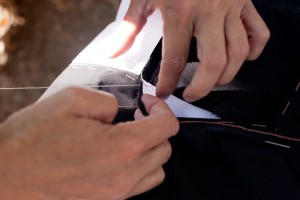The Kesa is the monk’s robe, and it´s sowing has been transmitted from Shakyamuni Buda to our times.
Kesa has its origin in the word “kesaya”, which signifies earth color and it recalls the aspect of the rice fields, linked together through canals at the Ganges’s valley. Since those far away times, the traditional assembling together of the cloth pieces is still being followed. While sowing them, we concentrate on the exact measures and on the stitch, which is very small, as a rice grain.
The Kesa is not a mere piece of cloth or a fashionable clothing object. It symbolizes the transmission of Buda’s teachings. Each Kesa is Buda’s original Kesa. When we wear it, we are dressed by the cosmic order. It’s the cosmic order which practices Zazen, and we ourselves are the cosmic order sitting in Zazen. The Kesa is material: it is composed of clothing and thread. It is also immaterial: the silent transmission from master to disciple.
 THE KESA BY MASTER KODO SAWAKI
THE KESA BY MASTER KODO SAWAKI
One day, an ‘unsui’ asked me about the meaning of the Kesa. I answered him: “The Kesa is something that is not clear”.
He looked at me surprised and astonished, his expression telling me he thought I was just blabbering.
Actually, the Kesa is undefinable, either by its “broken” color, a color of ruins or rags, and its dimension, which does not conform to any precise rule. It is not limited by any defined aspect that could contain it. That is the reason why it has been called “the rice field´s dress of the happiness without aspect”..
Read [+]
The transmission of Mahakashyapa to Ananda
Ananda asked Mahakashyapa: what did the Buddha give you, besides the golden Kesa?
Mahakashyapa answered: Ananda!
Ananda said: yes?
Mahakashyapa said: lower the flag mast in front of the door.
Ananda attained the great Satori. Read [+]

